Manaslu Circuit Trek location
The Manaslu Circuit Trek is located in the Gorkha District of Nepal, within the Manaslu Conservation Area. This area is known for its rich biodiversity and cultural heritage. The trek circles the majestic Mount Manaslu, the eighth highest mountain in the world at 8,163 meters (26,781 feet), along with other famous peaks like Himal Chuli, Nagdi Chuli, and Boudha Himal, crossing the Larke Pass at 5,106 meters.
The trek begins at Soti Khola or Machha Khola, which is approximately an 8-9 hour drive from Kathmandu by public vehicle. The trek ends at Dharapani or Besisahar, followed by a 6 to 10-hour drive back to Kathmandu. This trek offers adventurers an exciting and less crowded alternative to the more popular treks in Nepal.
Information on Manaslu Conservation Area Project
Manaslu Conservation Area Project (MCAP) is a protected area of Nepal and is located in the north center of Nepal it covers 1663 square Km in the Mansiri Himalayan range in the Gorkha District. It has established in 2055 B.S. (1998 A.D.). It is bounded by the Tibet border in the north and east, the Budi Gandaki River in the south, and the Annapurna Conservation area is the west border. The area took in mountains, glaciers, water sources, and forest in an elevation from 1400 m to 8,156 at the mount Manaslu
This project was initiated by National Trust for Nature Conservation (the king Mahendra Trust for Nature Conservation) a non-government organization and donated by many international trusts. Nowadays, this project is conserved by National Trust for Nature Conservation (NTNC) and the local people community from the local area.
This conservation is worthy of flora and fauna because this conservation is home to 33 species of mammals including Barking Deer, Musk Deer, Snow Leopard, Leopard, Blue Sheep, Himalayan Thar, and Black Beers as well as over 100 species of birds, three species of reptiles, four species of frogs and over 1500 to 2000 species of flower and plant.
How to go the Manaslu Circuit Trek?
The Manaslu Circuit Trek is situated in the Manaslu region. To reach the starting point of the trek, you can drive from Kathmandu to Soti Khola or Machhakhola by private jeep or public bus. The road condition is quite smooth with a blacktop surface until Taribesi. However, there is an off-road section between Dhading Besi and Taribesi. From Taribesi to Soti Khola or Machhakhola, the road remains rough, and you should expect a bumpy ride. This section can be particularly tough and challenging during the rainy season.
The trek begins from Soti Khola, following the Budhi Gandaki River through various villages and terrains before crossing the Larkya La Pass. The route then descends towards the Annapurna Conservation Area, from where you will travel back to Kathmandu.
Main Side trip during the Manaslu Circuit Trek
There are many side trips available during the Manaslu Circuit Trek, and you can consult with your trekking guide along the route to choose the best options. If you have extra time, you can extend your trek to include these side trips, going beyond the standard Manaslu Circuit Trek itinerary. Exploring these side trips will enhance your trekking experience and allow you to discover more of the stunning Manaslu region.
These side trips can be done as day hikes from the main trekking route, especially from Samagaun or Samdo villages. They add depth and variety to your Manaslu Circuit Trek, allowing you to explore more of the region’s unique landscapes and culture.
Some popular side trips are given below:-
- Pungyen Monastery (Pungyen Gompa) - 4100 meters high
Located near Samagaun, Pungyen Monastery (Pungyen Gompa) sits at an altitude of approximately 4,100 meters. It is the oldest monastery in the region and offers a glimpse into the area's rich Buddhist culture. Starting from Samagaun, the trail to the monastery provides stunning views of Mount Manaslu and the surrounding peaks, making it a rewarding experience both culturally and scenically. Since it is higher than Samagaun (3,530 meters), it serves as an excellent acclimatization hike before ascending further toward Samdo (3,860 meters) or Larke Pass (5,106 meters) on the Manaslu Circuit Trek.
- Birendra Lake – 3650 meters high
Birendra Lake is located very close to Samagaun, taking just 30 to 45 minutes to reach. Situated at the foot of the Manaslu Glacier, the lake lies at an elevation of 3,650 meters above sea level. This glacial lake is a beautiful spot for a short hike, offering tranquil waters and stunning mountain views. Set against a backdrop of snow-capped peaks and ice walls, it is incredibly photogenic — with reflections of the mountains perfectly mirrored on the still waters on clear days. Birendra Lake also serves as an excellent acclimatization hike for beginner trekkers before crossing Larke Pass.
- Manaslu Base Camp:- 4500 meters high
Manaslu Base Camp, situated at an altitude of 4,500 meters, serves as the starting point for climbers aiming to summit Mount Manaslu. It takes approximately 4 to 5 hours to reach the base camp, starting from Samagaun and ascending steadily. This trek requires physically fit trekkers due to its challenging terrain and longer walking hours, so it’s advisable to carry some snacks for the journey. A side trip to Manaslu Base Camp offers an up-close view of Mount Manaslu, a glimpse of the high-altitude environment, and an unforgettable high-altitude trekking experience.
- Samdo Ri:- 5200 meters high
Samdo Ri, also known as Samdo Peak, is located above Samdo Village at an elevation of 5,200 meters. This peak is a popular side trip for trekkers in the Manaslu region of Nepal. The ascent takes approximately 4 to 5 hours, offering breathtaking 360-degree views of the surrounding mountains, including Mount Manaslu. Samdo Ri is not only a rewarding destination for its panoramic vistas but also serves as an excellent acclimatization hike for trekkers preparing to cross the Larke Pass.
Although the hike is relatively long and challenging due to the high altitude, it is a highly rewarding experience for those with proper acclimatization and some high-altitude trekking experience. It’s important to pace yourself and allow sufficient time to complete this adventure safely.
Best Season for Manaslu Circuit Trek
If you are planning a trek to Manaslu Circuit, you have to choose the best time and season to explore the wonderful Manaslu region. All the trekkers have derived the common question, "when is the best time to Manaslu Circuit Trek” before planning the trip. So, you must know the best time to easily complete the Manaslu Circuit Trek. The best time provides you with an excellent trekking experience in travel life. Generally, trekking to a high altitude area is not an easy walk every month of the year because it is difficult to know the weather, temperature and direction above 3500 meters from sea level. The weather is quickly changeable during the summer and winter season in the mountain region, which makes it terrible to get to the target on time due to landslides and snow falls.
There are two main trekking seasons for Manaslu Region. Autumn trekking season (September to November) and spring trekking season (March to May) are the best trekking seasons in Nepal including Manaslu Circuit Trek. Even though the beginning of September to the end of November and March to May months are very good times for the Manaslu Circuit Trek because the weather is favorable for walking and the skies are clear to offer the magnificent views of the surrounding mountain. The temperature is suitable and ranges from 1 to 20 degrees Celsius which is perfect temperature and can drop to -8 in the night time. So, the weather is perfectly sunny and warm with wonderful mountain views, clean air and no rain and snow compared with other trekking seasons.
If you want and wish to avoid crowds and enjoy some alone time with nature and culture, you can do this trip during the winter (January and February) but you may face some potential hazard like the trails may be covered by snow, which makes it challenging to find the right target as well as raise risk of avalanches.
You can do trek in the summer season (June to August) but not good visibility due to rain but the best time for nature lovers. Summer season is also called the monsoon season in Nepal because it usually has heavy rainfall in the region. Heavy rainfall makes trails muddy and slippery and increased risk of landslides.
That’s why you have to choose the best season for Manaslu Circuit Trekking depending on your Vacations.
Requires Permits and Permits cost for Manaslu Circuit Trek
The Manaslu Circuit Trek is a restricted area trek situated in the Manaslu Region within the Manaslu Conservation Area. It was opened for trekking in 1991 A.D. and is known for its remote sector with simple accommodation and food. The Manaslu Region is protected by the Manaslu Conservation Area Project (MCAP), and all trekking activities are controlled by the government of Nepal. Therefore, you will need permission to trek in this region.
The permit cost for trekking in the Manaslu region depends on the number of days and the time of year. You will need different kinds of permits issued by the Government of Nepal because, after crossing the Larke Pass, you will enter the Annapurna Conservation Area. The required permits for the Manaslu Circuit Trek are as follows:
Manaslu Restricted Area Permit (RAP): The cost varies depending on the season and the number of days.
- Cost: USD 75 per person for the first seven days and an additional USD 10 each day from December to August and USD 100 for the first seven days and an additional USD 15 each day from September to November for all nationality
Manaslu Conservation Area Permit (MCAP): Required for trekking within the Manaslu Conservation Area.
- Cost: SAARC Nationals' entry fee is 1000 (one thousand) Nepali Rupees per person and 3000 (three thousands) Nepali Rupees for others nationality.
Annapurna Conservation Area Permit (ACAP): Required after crossing the Larke Pass and entering the Annapurna Conservation Area.
- Cost: SAARC Nationals' entry fee is 1000 (one thousand) Nepali Rupees per person and 3000 (three thousands) Nepali Rupees for others nationality.
Chum Nubri Rural Municipality Entrance fees: Required for visit the Chum Nubri Rural Municipality like villages of the villages of Sirdibas, Bihi, Prok, Lho, and Sama Gaun in the Nubri Valley, and Chekampar and Chumchet in the Tsum Valley.
- Cost: NPR 1,000 for foreign visitors and NPR 200 for local travelers per person.
Tsum Valley Trekking Permit
Tsum Valley Trek Permits cost USD 40 first seven days and an additional USD 7 each day from September to November.
Tsum Valley Trek Permits cost USD 30 first seven days and an additional USD 7 each day from December to August.
Also need Manaslu Conservation Area Permit (MCAP) and Chum Nubri Rural Municipality Entrance fees.
All of these permits are compulsory for your trek to Manaslu Region and your Trekking agency helps to issue all trekking permits.
Accommodation in Manaslu Circuit Trek
There are enough accommodations and restaurants along the Manaslu Circuit trekking trail for room and food, as new houses and rooms are added for trekkers every year up to Samdo Village. So, you can easily find comfortable accommodation until Samdo Village. However, at Dharmasala, there are limited teahouses, each with limited accommodations like dormitory-style rooms controlled by the Manaslu Conservation Area Project. During peak season, it can be difficult to find the best accommodations, so advance booking is recommended, which your guide can arrange for you. Almost all teahouses strive to provide the best service for travelers.
Normally, lodges have private rooms (2 beds per room) with shared indoor bathrooms, except at Dharmasala where the accommodations are similar to dormitory rooms. There are no luxury lodges like those found on the Annapurna Circuit or Everest Base Camp treks, but after crossing the Larke Pass, you will find fancier accommodations. Teahouses also offer hot showers for an additional fee. Charging electronic devices is usually available for a fee as well, but it's recommended to carry a power bank.
Food in Manaslu Circuit Trek
Food during the Manaslu Circuit Trek is primarily provided by the teahouses along the trail. Every teahouse has a food menu, and the food items are almost the same at every teahouse in each location. You can choose food from the menu based on your requirements. Most of the teahouses grow fresh vegetables in their gardens and serve them to customers, especially at lower altitudes.
The cooks are generally trained, but the taste of the food might be a bit different from Western cuisine. Fresh meat is difficult to find in the Manaslu region due to the Buddhist population living there, so it is advisable to be vegetarian during the Manaslu Circuit trek until you reach Bhimthang.
Breakfast:
- Porridge:Oatmeal or other grain-based porridge.
- Bread:Tibetan bread, chapati, or toast with jam, honey, or peanut butter.
- Eggs:Boiled, scrambled, fried, or in an omelet.
- Pancakes:Often served with honey, Jam or chocolate spread.
- Tea/Coffee:Local tea, black tea, green tea, or instant coffee.
Lunch and Dinner:
- Dal Bhat:A traditional Nepali meal consisting of rice, lentil soup (dal), vegetable curry, and sometimes meat. It is highly recommended due to its balanced nutrition and energy content.
- Noodles:Fried noodles, noodle soup, or Thukpa (Tibetan noodle soup).
- Rice Dishes:Fried rice or rice with curry.
- Momos:Nepali dumplings filled with vegetables or meat, served steamed or fried.
- Pizza:Basic pizza, often with a thick crust and limited toppings.
- Pasta:Simple pasta dishes like spaghetti or macaroni with sauce.
- Soups:Various soups, including garlic soup (recommended for altitude sickness prevention), vegetable soup, and tomato soup.
Recommendations
- Dal Bhat Power:As the saying goes, "Dal Bhat Power, 24 Hour!" It's a nutritious and filling option that provides sustained energy for trekking.
- Hydration:Stay well-hydrated by drinking plenty of water, tea, and soup.
- Energy Boosters:Carry high-energy snacks like nuts, chocolate, and dried fruits to maintain energy levels during the trek.
Drinking water in Manaslu Circuit Trek
Safe drinking water is an important factor during the trekking in Himalayas as Manaslu Circuit Trek. Staying hydrated is essential for successfully completing the trip, especially at high altitudes. Bottled water is available in teahouses and shops along the trek, but prices increase as you ascend, typically ranging from NPR 100 to NPR 500 per liter.
We normally recommend that all trekkers bring a water bottle due to the high environmental impact of plastic waste in the mountains. Teahouses provide boiled water for an extra fee, typically ranging from NPR 200 to NPR 400 per liter. Therefore, bringing a water bottle is highly recommended for all trekkers.
There are natural water sources available, such as streams, rivers, and tap water in many places along the trek, but this water should always be purified before drinking. For water purification, you can use water purification tablets, water filters, or UV purification. You can also ask your guide for information about safe drinking water during the Manaslu Circuit Trek.
Manaslu Circuit Trek Cost
The cost of the Manaslu Circuit Trek for a 12-13 day itinerary, including an additional 2 nights in a Kathmandu hotel, varies based on factors such as the level of service, group size, and trekking agency. However, our charge ranges from USD 900 to USD 1200 per person. This total cost includes 2 nights’ accommodation in Kathmandu, public transport as per the itinerary, guide and porter salaries, and three meals per day with one cup of tea or coffee per meal. However, please note that the overall cost may be higher than the base price due to additional expenses for extra food, drinks, hot showers, Wi-Fi, and other unforeseen costs.
If we breakdown the detailed cost, the total cost will seen very expensive than our base price because the overall cost is combined all together.
Communication in the Manaslu Circuit Trek
The Manaslu Circuit Trek is becoming a popular trekking destination in Nepal due to its cultural and natural beauty. There are good mobile network services around the Manaslu Circuit trekking area, though there are some spots with no coverage. Internet service is available throughout the region, but teahouses and lodges provide it for an extra charge.
If you do not have a Nepali SIM card for communication with your family and do not use the internet service, our guide can assist you in passing messages. Our guides always carry a cellular phone and regularly contact our Kathmandu trekking office to update them on the trek and your health condition. We are prepared to help with any problems during the trek.
Traveling is an important part of life, and we ensure you stay safe and healthy during your trekking in Nepal. Nowadays, you can get a local SIM card at Kathmandu airport upon arrival to use 3G and 4G internet services, as most trekking routes in Nepal have mobile network service. If you need a Nepali SIM card, we can provide it to you for your trek; just let us know before you leave for the trekking.
Manaslu Circuit Trek Difficulties
The Manaslu Circuit Trek is renowned for its breathtaking beauty and exceptional cultural experience. However, it is also known to be a challenging trek, primarily due to its high altitude, remote location, and rugged terrain. These challenges are important for trekkers to be aware of:
High Altitude: The trek reaches high altitudes, with the highest point at Larkya La Pass (5,106 meters or 16,752 feet). Altitude sickness can be a concern, so it's important to acclimatize properly and be aware of the symptoms.
Remote and Isolated: The trek is more remote and less developed than some other popular treks in Nepal. Facilities such as lodges and teahouses can be basic, and you may need to be self-sufficient at times.
Weather Conditions: Weather can be unpredictable, especially at higher altitudes. Trekkers should be prepared for cold temperatures, snow, and changing weather conditions.
Long and Challenging Days: Some days on the Manaslu Circuit Trek can be long and challenging, with steep ascents and descents. Physical fitness and stamina are important.
Permit Requirements: The Manaslu region requires a special restricted area permit, and trekkers are required to trek with a licensed guide. This adds to the cost and logistics of the trek.
Despite these challenges, the Manaslu Circuit Trek is an extremely rewarding adventure, offering stunning mountain vistas, matchless cultural encounters, and a reflective sense of achievement for those who undertake it. This trek is best suited for experienced trekkers who are in good physical condition, have previous experience trekking at high altitudes, and are prepared for the rigors of remote and rugged terrain. Sufficient preparation, including physical conditioning, acclimatization, the guidance of an experienced licensed guide, and appropriate gear, is essential for ensuring a safe and enjoyable trek.
Acclimatization for Manaslu Circuit Trek
High altitude sickness is a common issue in the high Himalayan areas, such as during the Manaslu Circuit Trek. It can develop quickly, but its symptoms are preventable. If you have previous high-altitude trekking experience, it can be beneficial. However, if you are new to trekking at altitudes above 3,000 meters, it is crucial to take precautions to prevent altitude sickness.
To prevent altitude sickness, follow these guidelines:
- Walk Slowly: Maintain a slow and steady pace.
- Drink Plenty of Water: Stay well-hydrated throughout the trek.
- Avoid Alcohol: Refrain from drinking alcohol as it can worsen symptoms.
- Ascend Gradually: Go higher in elevation gradually and sleep at lower altitudes.
- Acclimatization: Spend 2 nights at every 500 meters above 3,500 meters to help your body adjust.
All our trekking itineraries are flexible, including acclimatization days, and we prioritize your health and safety to ensure you complete the trek without problems. We provide basic medicine to support emergency situations if necessary.
It is important to inform your guide or leader about your health condition every day. They will assess your overall health and decide whether to continue the trek or return if needed.
Acclimatization day to reduce the Altitude Sickness for Manaslu Trek
An acclimatization day is necessary during the Manaslu Circuit Trek because it is located in high-altitude terrain, with Larke Pass at 5,106 meters. The trek starts at 750 meters Soti Khola and you gradually climb to 5,106 meters at Larke Pass, passing through several villages and high-altitude places. As you ascend, oxygen levels and air pressure decrease compared to sea level. Once you reach an altitude above 3,000 meters, you may experience symptoms of altitude sickness, such as nausea, vomiting, diarrhea, headaches, loss of appetite, tiredness, dizziness, and sleeplessness.
So, Samagaun is our acclimatization rest days in our itinerary. This rest days help prevent altitude sickness and allow you to adapt to the environment. If you experience any symptoms of altitude sickness during the Manaslu Circuit Trek, it is important to address them immediately to avoid difficulties in completing the trek. To prevent these issues, you should follow your guide's instructions, as they are knowledgeable about high-altitude sickness.
When ascending on the Manaslu Circuit Trek from Lho Village, be honest with your guide about how you are feeling. Your guide will advise you to walk slowly and may suggest that you sleep at a lower altitude before ascending further. This practice, known as acclimatization, helps reduce the risk of altitude sickness.
To prevent altitude sickness, you should follow the itinerary closely, as proper acclimatization helps your body adapt to higher elevations. Additionally, stay hydrated by drinking plenty of water, eat a well-balanced diet with sufficient carbohydrates, maintain a comfortable pace, and avoid alcohol and sedatives. By adhering to these guidelines, you can reduce the risk of altitude sickness and have a safer and more enjoyable trek on the Manaslu Circuit. However, if you continue to feel unwell despite following these recommendations, you should return to a lower altitude.
Tipping information
The guide, porter, driver, and all the supporting staff who contribute to the successful completion of your trek expect tips as a gesture of appreciation. Tipping is a way to acknowledge their efforts and is typically given at the end of the trek. It is customary for travelers to tip around 10% of their total payable amount, but you can adjust this based on the quality of their services.
The High Pass Adventure team, who will be taking care of you throughout the Manaslu Circuit Trek, is motivated to provide outstanding service and ensure you have an inspiring, once-in-a-lifetime experience. Your tips help to recognize their hard work and dedication.
Trip extension
If you have extra time after completing the trek, you can do different activities or different short treks in Nepal. We have many short tour packages and adventure activities such as Chitwan National park and Bardiya National Park for Jungle safari tours. You can visit Pokhara city, Nagarkot Hiking, and Dhampus on hiking or day Rafting trips in the Trisuli River.
Adventure activities are paragliding, canoeing, Ultra light flight, Bungee Jump, and Mountain Biking. All packages are extra activities as optional tours and are not included in your package cost. If you will do these activities after the trip with us, we arrange them at a reasonable cost and we give you a good discount.
Trekking Gear List
Travel equipment is necessary to pack before you travel. We hope it is too much to carry from your home to other countries but some are the necessary equipment can be hired or bought in Kathmandu around Thamel.
These general equipment are for all seasons while trekking in Nepal, but may be different as per the different seasons and duration of trekking routes on your chosen trip.
Documents:
- Passport and 4 passport-size photos
- Travel insurance details (in case an emergency evacuation, if needed)
- Boarding passes for flights
- Driver’s license (if needed)
- Cash USD
- Credit/Debit Card (Ensure you have $500 on your card in case an emergency helicopter evacuation is needed)
Sleeping:
- Sleeping bag (Comfort rating -15 Celsius recommended)
- Sleeping bag liner (Optional)
Footwear:
- Trekking boots: one pair of lightweight
- Sandals for city and tea house footwear
- Shoes for the plane and tea houses (Optional)
- Gaiters for hiking in winter to the base camp
- Thin, lightweight inner socks
- Thick, warm wool hiking socks
Clothing for the body:
Please make sure that you have non-cotton clothing for trekking.
- Base-layer t-shirts (e.g. running t-shirts)
- Fleece/Windproof jacket
- Waterproof jacket
- Down jacket for warmth
- Travel clothes and City Wear
- Underwear
- Base-layer trousers (optional)
- Waterproof trousers
- Trekking trousers
- Trekking shorts (Optional)
- Gloves and wool hat
- bandanna or scarf
Health Requirements (Basic First Aid Kit)
- First-aid kit; should contain lip salve, Aspirin, Band-Aids, anti-histamine, Imodium, or similar tablets for mild cases of diarrhea
- Re-hydration powder, extra prescription drugs you may be taking if any particular
- Wet wipes for cleaning can be purchased in Kathmandu
Others:
- Sunglasses and Sun cream
- Towel
- Book (reading and writing materials)
- MP-3 /Music, headphones, and ear plug (who knows some people in the group are snoring) as optional.
- Travel wash
- Hand sanitizer, wet wipes
- A day bag: 35 liters
- A duffel or rucksack with straps to go over your back (Max 12 kg of weight for porters to carry)
- Dry Liner or Dry Bag
- Water bottle/thermos/ camel bag: At least 2 L. Nalgene bottles best.
General Toiletries
- Toilet papers/ tissue
- Contact lenses, Glasses (if needed)
- 1 medium-sized quick drying towel
- Toothbrush/paste (preferably biodegradable)
- Multipurpose soaps (preferably biodegradable)
- Nail clippers
- Face and body moisturizer
- Feminine hygiene products
- Small mirror
- On Personal Hygiene
- Wet wipes (baby wipes)
- Anti-bacterial hand wash
Others (optional)
- Trekking Poles
- Large plastic bags – for keeping items dry inside your kit/duffel bag
- Travel games i.e. chess, backgammon, and scrabble. (for luxuries)
- Binoculars (for luxuries)
- Trail Map/Guide book (if you are alone)


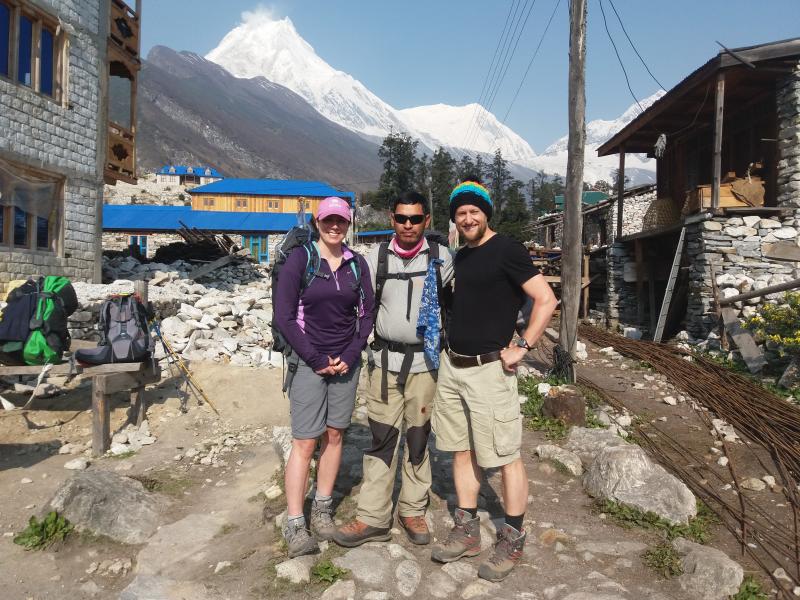




 USD 1050
USD 1050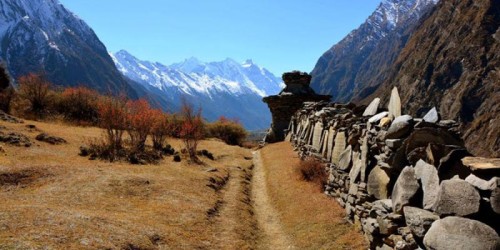
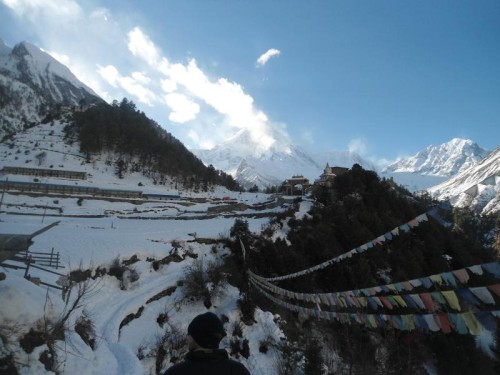

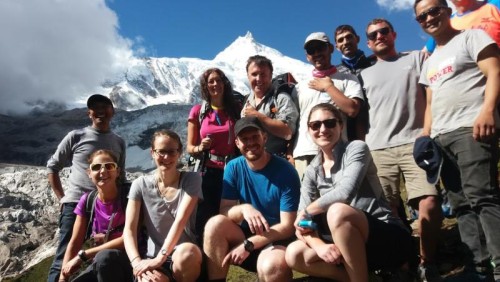
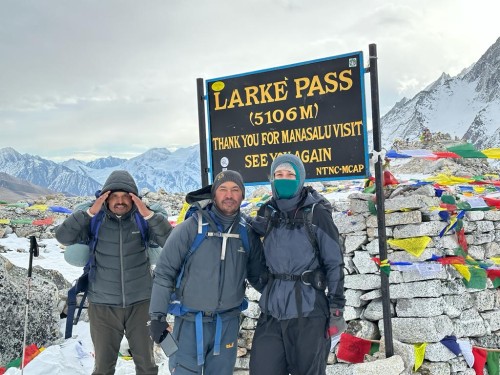
Jacob Dexter
New Zealand
Perfect Guide for our Trekking
14th June, 2023
Purna was a guide for a customized marathon near month-long trek along the Manaslu, Annapurna and Nar Phu valleys, including Manaslu Base Camp and three high passes (Larkya La, Kang La and Thorung La passes).
Gosia Wlosek
Australia
Amazing Manaslu Circuit Trek
11th July, 2023
I have recently returned from an amazing Manaslu Circuit Trek. I found the High Pass Adventure to be really well-organized with informative communication from first contact to till I got home. Purna always quickly answered all our questions which made us feel very secure and easily prepared. The guide spoke excellent English as well as the guide and porter were of the highest quality with suitable equipment. I would highly recommend the High Pass Adventure to all my relatives, family, and colleagues as well as to anyone looking for well-organized trekking in Nepal.
Daniel Francis
Austria
Best trekking experience with High Pass Adventure
11th July, 2023
My boyfriend and I did the Manaslu Circuit Trek in April 2019 with High Pass Adventure. This is our third time traveling Nepal but first time with Purna, and it was one of the best experiences we've ever had. Purna, owner of the High Pass Adventure was great and he helped us to prepare and answered any question we had really quickly with helpful advice. . We felt that it was very hard to complete the Manaslu circuit trek but they were well- equipped for safety and the guide took care of us every second. The Trek itself is absolutely surprising and we really had a wonderful and memorable trek with them. Again I will come to Nepal for my next trek and use a High Pass Adventure trekking agency.
Thomas and Charlotte
Denmark
Excellent company, don't hesitate.
15th March, 2024
Very professional company who provide all needed info and guidance. No surprises. Booked after a quick whatsapp call with the actually guide we were assigned (Gyan). Prices are very competitive and their website has a lot of info. Meet 2 of the 3 managers personally and had a chat with the 3rd one who was trekking himself elsewhere, but still had time to give hints.
Weather was a bit dodgy but our guide helped take the right decision to be able to complete the Manaslu Circuit and Larke Pass. Gyan acted as porter cum guide but stood out as sometimes a better guide than the "real guides" I meet assigned to other travelers from various countries. Excellent English and friendly, willing to share about his life and Nepalese habits and customs.
Great trip, good advice from before trip and all the way to the finish line....
Would gladly book with them again if ever in Nepal.